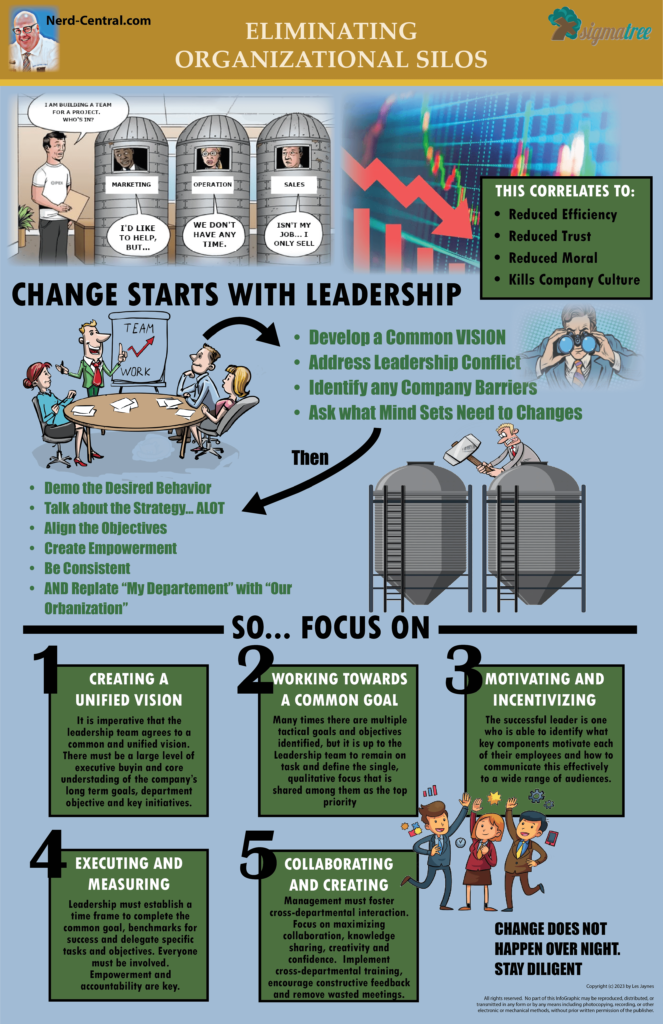Many organizations today that struggle with change and fall short of fulfilling their ultimate vision spend countless days, weeks and months – not to mention resources – trying to understand why they can’t seem to circumvent the barriers standing in their way and in most cases they can’t quite define what those barriers are.
The silo mentality can be defined as a mind-set present when departments or business sectors do not wish to share information or work together as a team with others in the same organization. This type of mentality will reduce efficiency in the overall operation, reduce trust and morale, and may contribute to the demise of a productive company culture.
Silo is a business term that has been passed around and discussed at many boardroom tables over the last 30 years. Unlike many other trendy management terms this is one issue that has not disappeared over the years. Departmental silos are seen as a growing pain for most organizations of all sizes. It is the duty of the executive leaders and management to prepare and equip their teams with the proper mind-set and vision to break down these destructive organizational barriers.

The Structures Holding You Back
I can’t think of many organizations out there that don’t want to be more collaborative, have an aligned vision, communicate better or improve trust and accountability. You don’t have to be a CEO or have a MBA to understand how all of those things, when executed well and ingrained in the culture, would lead to amazing financial returns. However, many organizations struggle with their historical systems and structures not wanting to move away from them. Fearing the loss of control.
Talking about “more” collaboration and creating cross-functional teams is great, but this can also fail miserably without a clear shared understanding of the narrative behind the ultimate mission. Often, at least from an outside perspective, internal vertical alignment as to the mission at hand can be fine while horizontal alignment across silos is lacking. The sub-cultures and ideas on how to achieve the goal may vary which leads to these departments, divisions or “cross-functional” teams to actually work against each other in many ways.
And sometimes, silos exist both vertically and horizontally at the same time. Senior leaders don’t have enough access to important ground intelligence from their front-line troops while directives and information from the top gets lost in translation on its way down.
The Behaviors and Mindsets That Need to Shift
The silo mindset does not appear accidentally nor is it a coincidence that most organizations struggle with interdepartmental turf wars. We must address the fact that organizational silos can also be the result of a conflicted leadership team, and that conflict trickles down causing unrest and employees becoming fearful of sticking their necks out.
Many executives may look at their organization and dismiss department inefficiencies and lack of cross-functional solutions due to immature employees, lack of basic training, or simply the inability for some employees to play nicely with one another. Unfortunately, while these behaviors may be a result of the silo mentality; it is not usually the root cause. These assumptions will actually lead to long term harm to the organization as a whole by creating resentment and cynicism within the teams. It is the responsibility of the leadership team to recognize this and rise above to create effective, long-term solutions that are scalable, executable, and realistic.
Organizations that will succeed in this more volatile and complex business environment have to not only develop and regularly communicated an aligned vision – and the specific narrative to support it – but also answer the questions:
“What behaviors and mindsets need to change in order to accomplish this goal?”
“What barriers need to be broken down to accomplish this change effort?”
More meaningful relationship building outside of the silos people exist in will gradually dilute the strength of those barriers. This also improves trust and willingness to regularly share important information. Everyone is working towards a common goal and all understand their roles in moving the ship in that direction.
It didn’t happen overnight, but when senior leaders gets behind this change effort, start demonstrating new behaviors and talk about the new vision every day; only then does the culture start to shift and align with the vision and strategy.
Here are 5 steps to encourage a unified front and open up the lines for communicating a powerful vision for change.
1. Create a Unified Vision.
Silos – and the turf wars they enable – devastate organizations. They waste resources, kill productivity, and jeopardize the achievement of goals. Leaders are advised to tear down silos by moving past behavioral issues and address the contextual issues that are present at the heart of the organization. For many organizations, this means that not only do all employees of the company need to row in the same direction, but the executive teams must be engaged and at the forefront steering the boat.
It is imperative that the leadership team agrees to a common and unified vision for the organization. There must be a large level of executive buy in and core understanding of the company’s long-term goals, department objectives, and key initiatives within the leadership team prior to passing it down to the teams. A unified leadership team will encourage trust, create empowerment, and break managers out of the “my department” mentality and into the “our organization” mentality. And the leaders must be consistent with all of their behaviors first before others will follow.
2. Work Towards Achieving a Common Goal.
Once the leadership team has agreed to the over-arching unified vision of the organization, it is important that this team determines underlying root problems that may be causing the ripple effect of silos. Many times there are multiple tactical goals and objectives identified, but it is up to the Leadership team to remain on task and define the single, qualitative focus that is shared among them as the top priority. Once the “elephant in the room” has been identified it is important that all executives and all members of management work together towards achieving that common goal. It is also important that all employees are aware of this objective and understand how they can make an impact individually.
In Virginia Anderson and Lauren Johnson’s book, Systems Thinking Basics, they define systems thinking as a holistic and big-picture view of the whole. It is recognizing the interconnections between parts of a system and synthesizing them into a unified view. This thinking, along with a unified focus, should be applied across teams to encourage collaboration, team work and ultimately accomplishment of the common goal.
3. Motivate and Incentivize.
Kudos to execs and management teams who are able to successfully establish a unified, common goal and understand how the various parts of a whole intertwine. Half of the battle is won. The final steps in eliminating silos cover execution and implementation. Motivation can vary across teams, and most importantly across individuals. What really defines a successful manager is one who is able to identify what key components motivate each of their employees and how to communicate this effectively to a wide-range of audiences. Once the common goal has been identified, each member of the management team must incentivize their employees accordingly.
If your common goal is to revamp the reputation of your company, then one of your objectives might be to improve the quality of your product. If the objective is to improve the quality of the product then your employee incentives should be built to maximize this desired result. For example, someone in product development might receive an incentive for reducing bugs within deadline; while the customer service representative might receive an incentive on increasing customer satisfaction. Incentives will go a long way with motivating employees; however, it is not all that is needed. Managers need to remember that motivation encompasses a wide variety of tactics including common interests, individual investment in growth, shared voice, and positive words of encouragement. All of the tactics described within Motivation are designed to avoid the “it’s not my job” attitude and encourage input, team work, and most importantly – productivity.
4. Execute and Measure.
Just like any established goal, it is important that once this goal is defined, it is also measured accurately. The leadership team must establish a time frame to complete the common goal, benchmarks for success and delegate specific tasks and objectives to other members of the management team, and down to front line troops. Empowerment and accountability are key.
It is not uncommon that a large amount of inertia is needed to keep the momentum going. Let’s not forget that teams thrive off routine and constant reinforcement. Team work and constant cooperation must be present for the above 3 steps to work properly.
5. Collaborate and Create.
The famous quote by Francis Bacon “knowledge is power” has a very pivotal role in modern organizations. There are a few key factors in creating a thriving and productive team; knowledge, collaboration, creativity, and confidence. Without these four basic factors any team is destined to fail.
To encourage your teams to exhibit all 4 of these traits it is recommended that management allows and fosters cross-departmental interaction. The exchange of knowledge and the collaboration that will inevitably take place between teams is absolutely priceless. To maximize collaboration, knowledge, creativity and confidence it is suggested that management works to reduce unnecessary long and frequent meetings, builds out accessible and small meeting rooms, implements a cross-departmental training system, and encourages constructive feedback from outside departments.
Summary
Breaking down the silos is not an easy task for any organization; however, the avoidance of these issues will be more detrimental to the employees and ultimately the overall ability to unite by any transformation effort. The five steps are designed to help facilitate a unified vision and establish realistic steps to providing team members with a clear purpose and means to accomplishing the ultimate common goal. There is nothing more powerful in any organization than having all employees rowing fiercely in the same direction.
And again, these visions don’t have to be overly complex or be wild leaps at greatness. They have to be something that the team can connect to, where everyone understands how not only to talk their way to the win, but to behave their way there. A clearly communicated vision, a little restructuring and shift in mindsets coupled with consistency and discipline is how the best organizations are going to thrive.




